des . 27, 2024 03:52 Back to list
dust seal vs oil seal
Dust Seal vs. Oil Seal Understanding the Differences and Applications
In the field of machinery and mechanical engineering, seals play a crucial role in ensuring the longevity and efficiency of equipment. Among various sealing solutions, dust seals and oil seals are two commonly used types, each serving distinct purposes. Understanding their differences, applications, and benefits is vital for engineers and technicians involved in equipment design and maintenance.
What is a Dust Seal?
A dust seal, also known as a dust cover, is a protective barrier designed to prevent the ingress of dust, debris, and other contaminants from entering sensitive machinery components. Often made from materials such as rubber or plastic, dust seals are utilized in environments where dust and particulates are prevalent. Their primary goal is to maintain cleanliness and protect internal components, such as bearings, gears, and shafts, from wear and tear caused by external particles.
Dust seals can be found in various applications, including automotive wheel bearings, industrial machinery, and outdoor equipment. They are particularly crucial in dusty environments, such as construction sites or agricultural fields, where the accumulation of dirt can lead to mechanical failures.
What is an Oil Seal?
An oil seal, or shaft seal, is a component designed specifically to contain lubricants within machinery while preventing the leakage of oil or other fluids. Typically made from elastomers, such as nitrile or fluorocarbon rubber, oil seals often feature a specific lip design that creates a tight seal against rotating shafts. This design allows them to withstand high pressures and temperatures, making them suitable for various machinery, including engines, transmissions, and hydraulic systems.
The main function of an oil seal is to retain lubricants, reducing friction and wear between moving parts while minimizing the risk of fluid leaks that could lead to environmental contamination or operational inefficiencies. Oil seals are essential in applications where lubrication is necessary for the effective functioning of the mechanical system.
Key Differences Between Dust Seals and Oil Seals
dust seal vs oil seal

1. Primary Function - Dust Seal Prevents the entry of dust and contaminants. - Oil Seal Retains lubricants and prevents fluid leakage.
2. Material Composition - Dust Seal Typically made from softer rubbers or plastics. - Oil Seal Often constructed from more resilient materials capable of withstanding oils and chemicals.
3. Design - Dust Seal Usually features a straightforward design without complex lip arrangements. - Oil Seal Incorporates lip structures designed to create a seal against rotating shafts.
4. Applications - Dust Seal Commonly found in outdoor and abrasive environments. - Oil Seal Used in machinery requiring lubrication, such as engines and gearboxes.
When to Use Each Seal
Selecting between a dust seal and an oil seal often depends on the specific requirements of the application. For machinery exposed to high levels of dust and particulates, a dust seal is essential to protect vital components from contamination. Conversely, in applications where lubrication is crucial for operation, oil seals are necessary to maintain the integrity of fluids and prevent leaks.
In some cases, both seals may be utilized in conjunction to provide comprehensive protection. For example, in an automotive application, an oil seal may be used to contain oil within the engine, while a dust seal protects the bearing from dust ingress.
Conclusion
Understanding the distinctions between dust seals and oil seals is crucial for ensuring optimal performance and longevity of machinery. By selecting the appropriate seal for specific applications, engineers and technicians can enhance equipment reliability, reduce maintenance costs, and improve overall efficiency. As industries continue to evolve, the role of seals in protecting machinery remains indispensable, demonstrating the necessity of informed decision-making in the realm of mechanical design and maintenance.
-
The Trans-formative Journey of Wheel Hub Oil Seals
NewsJun.06,2025
-
Graphene-Enhanced Oil Seals: Revolutionizing High-Pressure Oil Sealing
NewsJun.06,2025
-
Future of Hydraulic Sealing: Advanced Intelligent TCN Oil Seals
NewsJun.06,2025
-
Don’t Let a Broken TCV Oil Seal Ruin Your Day
NewsJun.06,2025
-
Bio-Inspired Dust Seals for Better Sealing Performance
NewsJun.06,2025
-
Biodegradable and Sustainable Hydraulic Seal Materials
NewsJun.06,2025
-
Top Oil Seal Solutions for Your Industrial Needs
NewsMay.22,2025
Products categories
















